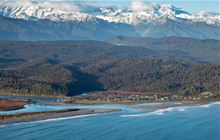Rowi
Introduction
Rowi are the rarest of the five species of kiwi. Through predation and habitat loss, these remarkable birds have been reduced to just one natural population.New Zealand status: Endemic
Conservation status: Nationally Endangered
Population: About 450 (in 2015)
Found in: Ōkārito forest and surrounds in South Westland, predator-free islands of Marlborough Sounds
Threats: Predation
Species information: Ōkārito brown kiwi on NZ Birds Online
Rowi conservation
There is one natural population of about 450 rowi (Apteryx rowi) in Ōkārito forest and surrounds in South Westland. Ōkārito was designated as one of the five special Kiwi Sanctuaries in 2000. Rowi can also be found on two predator-free islands in the Marlborough Sounds, following successful translocations of birds.
Unlike some other kiwi species, male and female rowi both take turns incubating their eggs. Although they do not rely on their parents for food and protection (all kiwi chicks are self-sufficient as soon as they hatch), rowi juveniles often stay with their family group for years.
Rowi are slow breeders, normally laying just one egg per year – making the death of an adult bird all the more devastating to the population.
Operation Nest Egg
The biggest threat to rowi survival is stoats. Trapping failed to stop the stoats and rowi numbers were declining quickly. With the support of Kiwis for Kiwi, DOC established Operation Nest Egg (ONE).
Operation Nest Egg involves removing eggs from the risk of predation, hatching them in captivity, and placing the chicks in a predator free environment until they are big enough to fend for themselves (between 1 to 1.2 kg). They are then returned to the wild.
Unmanaged, a tiny proportion of kiwi eggs produce an adult bird.
Roughly 80 rowi eggs are laid each season, 40 of these eggs fail to even hatch. Of the remaining 40, 28 are killed by stoats, and about 8 die of natural causes or killed by predators. This leaves just 4 chicks alive after the first 6 months Of these 4 chicks, only 2 will survive over 1 year to make it to adulthood.
However, using Operation Nest Egg the number of birds to make it to adulthood rises from 2 to approximately 50 per season. The aim is to increase the rowi population to 600 birds by 2018.
New populations
Rowi that have come through ONE have been used to establish new populations on pest free islands. Mana Island is one of these, and in 2016 we confirmed the first rowi breeding there. Islands can however be limiting because adult kiwi need very large territories.
Group effort
We work with a number of partners and groups to help rowi.
- Our key partner is Te Rūnanga o Makaawhio and Ngāi Tahu, who we work with to make decisions on the future of rowi management.
- The West Coast Wildlife Centre incubates and hatches the majority of eggs we collect from Okairto forest.
- Willowbank looks after the hatched chicks, making sure they're healthy.
- Air New Zealand provides transportation between facilities.
- E-Ko Tours advocates for kiwi, and provides boat transport for kiwi ready for release to pest free islands.
- A dedicated group of volunteers carry out pest control on Kaipupu Point, used as a creche in the Marlborough Sounds.
Intelligent transmitters
Using the latest monitoring technology, we can keep a close eye on rowi. DOC has worked with a private business to develop ground-breaking technology specifically for our kiwi conservation work.
To track rowi, transmitters are attached to their legs. By monitoring the bird’s activity levels, these intelligent transmitters tell us where the bird is, when an egg is laid and when a chick hatches.
A system for data collection (nicknamed ‘Sky Ranger’) involves a program fitted to a fixed wing plane that flies over the forest searching for signals. This means transmitter signals, that might have taken 45 days of groundwork to complete, can now be gathered during a two-hour flight. The information collected lets us know what pairs are incubating and when we should collect the egg.
Contact
| Westland Tai Poutini National Park Visitor Centre | |
|---|---|
| Phone | +64 3 752 0360 |
| westlandnpvc@doc.govt.nz | |
| Address | 69 Cron Street Franz Josef Glacier 7856 |
| Hours | Visitor centre hours and services |

